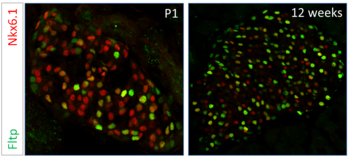Marker for beta-cell maturation
Keywords
Marker,beta-cell maturation,Diabetes,Flattop,proliferative,Langerhans islets
Challenge
The regeneration of functional beta-cell mass is a primary goal in patients with type 2 diabetes. This can either be achieved by replenishing the lost beta cell mass or by regenerating dedifferentiated beta-cells. The development of novel therapies and the identification of novel drugs will require suitable assay formats and novel marker proteins. Thus, there is a high demand for marker proteins that clearly correlate with the status of mature beta-cells characterized by glucose-dependent insulin secretion, a high degree of cellular polarity, enhanced levels of glycolysis enzymes and signaling receptors for major beta-cell regulatory pathways.
Technology
Flattop (Fltp) was identified as a novel gene involved in planar cell polarity (PCP) which is essential for asymmetric cell division as well as the coordination of cell migration and orientation within epithelial cell layers. In beta-cells Fltp expression rapidly increases during postnatal beta-cell maturation. In addition, Fltp expressing cells show a decreased proliferation rate compared to Fltp negative cells. This data reveals a PCP-mediated functional heterogeneity among insulin-producing beta-cells. Thus, Fltp can be used as a novel marker protein to distinguish between Fltp negative proliferative beta-cells and Fltp positive mature beta-cells within the three-dimensional architecture of Langerhans islets as well as in cultures of beta-cell derived cell lines.
Commercial Opportunity
The technology is available for in-licensing and further co-development especially for collaborative screening projects and assay development.
Development Status
Proof of concept was demonstrated with a FltpZV knock-in/knock-out mouse model (Fltp open reading frame replaced by a multicistronic lacZ-Venus reporter cassette) and in murine insulinoma cells. Validation was performed in human beta-cell lines as well as with human and mouse Langerhans islets.
Patent Situation
In 2014 a priority claiming patent application was filed in Europe, followed by a PCT application (WO2015/144861). National phases were entered in US (US2017153224), EP (EP3123169) and JP (JP2017516457).
Further Reading
A scientific paper describing the role of Fltp in proliferative and mature beta cells has been published in Nature:
Bader et al. (2016): "Identification of proliferative and mature β-cells in the islets of Langerhans". Nature 535, 430-434 (<link www.nature.com/nature/journal/v535/n7612/full/nature18624.html - external-link-new-window>http://dx.doi.org/10.1038/nature18624</link>).
Gegg et al. (2014): "Flattop regulates basal body docking and positioning in mono- and multiciliated cells". Elife, Vol. 3: e03842 (<link www.ncbi.nlm.nih.gov/pmc/articles/PMC4221739/pdf/elife03842.pdf _blank external-link-new-window>http://www.ncbi.nlm.nih.gov/pmc/articles/PMC4221739/pdf/elife03842.pdf</link>) describes current Fltp mouse models.





